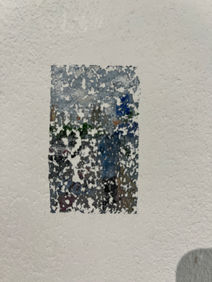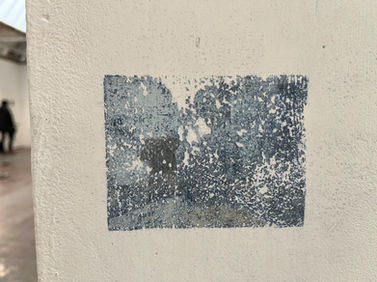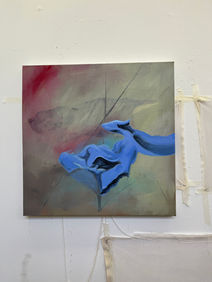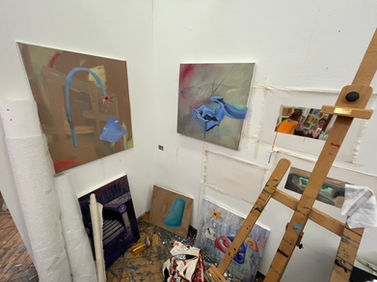Process
Book
My first book was quite long with the pages getting shorter in length as they reached the middle spread. and the height was the same on all pages. The paintings peeking through behind the shorter pages made me want to explore this cropping and framing idea more. Treating the whole spread as a painting with multiple compositions as you flicked through the pages.
Again I started with strips of canvas that I ripped and soaked in watery washes of gesso, maybe 2-3 washes depending on the consistency. I like that some pages are whiter and others are more rawr. Tonally different and different to paint on.
This time I wanted to experiment more with shapes and composition within the book… cutting the paintings and cropping them from view.. Giving the viewer a hint as to what’s coming next. The overall shape of the book is square which is a shape I am comfortable with finding and expressing compositions through thanks to instagram.
This process was again assisted by these second hand frames… second hand frames for second hand images… bridging the gap between the digital image and the analog paint. I chose images by holding a frame up to my ipad and flicking through my archive. I continued using the images from the same time period as my first book. The compositional layout of the page came first so the frame chose the image and from there I tried to piece pieces together. There was a balance I had to find between being narrative contextually and the paintings being visually complimenting. I layed out the pages and flicking through the book felt like driving through the streets of a city with windows to different moments of family life.
Hand stitched the book together for the Wilson’s Road show. I want the spine of the book to be the exposed stitches that bound the pages together. I measured the holes I had to punch at intervals. All the pages were different heights, so I had to find a measurement for a length which could be divided in a way that secured each page firmly. So that the bottom and top of each spread was secure.
I showed the book unfinished and the book still remains unfinished
There are parts that work and parts that need more space and rethinking. I painted pictures from my most recent trip and I was kind of thinking of an old testament new testament “vibe” but, I’m not sure how that will work quite yet. What it will mean… and if I want it to mean what it will mean. One thing I noticed when painting the new images that I had taken, versus the 20 year old low quality images taken by my dad, was my application of paint. - I was harsher and less kind with the paint. I was in a hurry and it felt desperate. Desperate to prove something. Maybe that “I was there… I was there... This happened… I belong…” All I am certain of is that the paintings I did from the hard drive images I layered with light watery washes of acrylic and slowly built up the image usually by placing a block background colour followed by shapes that build the background of the images and finally layering the foreground on top. (show bike painting) Perhaps My painting of the images I took came too soon … I started working on them only a week after my arrival. There felt to be a lot at stake. I was sad to be back confused as to what just happened and wondering where it all stands in the present. Who knows did it really happen? What is true… only memories are left.
My reflection on this: It is sad that I couldn't give titles to each painting that will only be viewed once opened again symbolic to the digital process however I desire to give them more space.
Also, I should add that I only painted images taken on my phone for the book and images taken by my camera are painted on the walls. Something about this book feels a bit more like a scrap book and personal… The phone being a personal image capture device, whereas the camera is used as a more objective lens.
Currently I have plans on taking the book apart and reconfiguring it. Perhaps mixing the old with the new and adding more space to some images.
Wall paintings
a/eshkal: shapes / problems
This process started similar to the book. Although, because I was in Iran, I only had one small frame. So I decided to break down the elements of the frame - something that Simon Callery noted as an act of breaking down the traditional tools for painting.
In Tehran I was responding to the graffiti and space quite frantically and fanatically… I painted the first session in 1 hour; applying the block colour of the square, waiting for it to dry while choosing and filling in the next spot and then moving between paintings like that. I came back early on the day of the event and painted another hour and added 4 more pieces and touched up some of the others. In total I painted 7 images. All the images were taken by me in my previous trip 3 years prior.
The whole event was a blur and the documentation I have was final. I never went back to space.
Painting onto the studio walls
Only after I left and the feedback I got from others did I realise the meaning of what I had left in Iran.
I followed the same technique as I did in Iran. Using the same frame broken down into its 3 elements
The outer frame, the inner frame and the outline of the glass. Same process of building up colours in blocks of shapes and gestures. Responding to the environment.
Actually the paining next to the sink used one of the old frames I had used a lot in my books… but I decided it felt wrong… and would make too many decisions in my brain. So I kept using this one small frame and it’s 3 different elements.
I was painting pictures from my most recent trip this time.
Copeland Gallery
Same frame, same game. I went back to painting from the archive of images from the 2019 trip and some older from when I lived in Iran. This was more about bringing the past to the present.
A new process in this series of works happened here when I had to “delete” the paintings from the walls.
I sanded them down and then painted over them with white emulsion. Using painting and decorating tools.
Stretched paintings
This was the first time I made and stretched my own canvases.
I started out by priming the canvases similarly to how I primed the book. Painting on them while pinned to the wall with light washes of colour. And photographing them as I went.
Concrete peel paintings
Started by painting the peelable paint on the walls and then I let it dry. At first I was using the frame but then I got more loose with the shapes and let them drip. Next time I will push this further.
Then I painted images onto the grey peel-y paint, using photos from my phone this time (like the book). Images from my recent trip. I then peeled them off the wall and transported the pure paint home in an exhibition guide from South London Gallery. I then created cardboard moulds which I poured my concrete mix into and let dry. The first text I accidentally moved the paint peel so it turned out scrunched up but I liked it. Luckily it was just a very loose self portrait.
The moulds were made from two layers of cardboard made into a box and with sellotape inside to make it waterproof.
I experimented with carving into the back of the pieces while the concrete was still wet. Then I took them out of the moulds and let them air dry a bit more. I used a dremel to clean them up and carve into some of them to accentuate certain marks left by my cardboard mould.
Exhibiting the concrete paintings forced me to think about different methods of display. I used 4 nails - it was important the aesthetic quality of the nails. It was harder to put up. Unlike the convenience of a stretched painting.
I really want to push this further by creating concave moulds and playing with the movement of the paint peels and also smashing them and then trying to put them back together.
Studio pics and some of the ongoing Layer paintings
Bonus!!
I've put these paintings aside for now and will come back to them soon...




















